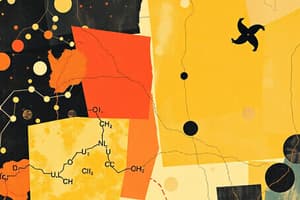Podcast
Questions and Answers
Which phospholipid is most commonly found in cellular membranes?
Which phospholipid is most commonly found in cellular membranes?
- Phosphatidyl-inositol (PI)
- Phosphatidylserine (PS)
- Phosphatidylcholine (PC) (correct)
- Phosphatidyl-ethanolamine (PE)
What role does dipalmitoyl (C16)-PC serve in the lungs?
What role does dipalmitoyl (C16)-PC serve in the lungs?
- Reduces surface tension in the alveoli (correct)
- Constituent of bacterial membranes
- Involved in intracellular signaling
- Synthesized in sufficient quantities by the body
Which structure is formed by amphipathic lipids when they create a confined aqueous compartment?
Which structure is formed by amphipathic lipids when they create a confined aqueous compartment?
- Monolayer
- Bilayer sheet
- Vesicle (correct)
- Micelle
Which phospholipid serves as a signal in apoptosis?
Which phospholipid serves as a signal in apoptosis?
What distinguishes detergent molecules from membrane lipids?
What distinguishes detergent molecules from membrane lipids?
Which statement accurately describes the structure of phosphatidylserine (PS)?
Which statement accurately describes the structure of phosphatidylserine (PS)?
What is the primary role of lipid bilayers within cells?
What is the primary role of lipid bilayers within cells?
What is the role of cardiolipin in cellular membranes?
What is the role of cardiolipin in cellular membranes?
What type of lipid structure has its non-polar parts together and polar parts interacting with water?
What type of lipid structure has its non-polar parts together and polar parts interacting with water?
Which model illustrated the bilayer nature of cellular membranes?
Which model illustrated the bilayer nature of cellular membranes?
Which phospholipid is involved in releasing calcium through inositol phosphorylation?
Which phospholipid is involved in releasing calcium through inositol phosphorylation?
What is a defining feature of micelles in comparison to bilayers?
What is a defining feature of micelles in comparison to bilayers?
What characterizes phosphatidyl-ethanolamine (PE) in biological membranes?
What characterizes phosphatidyl-ethanolamine (PE) in biological membranes?
Which phospholipid is less common than phosphatidylcholine (PC) and phosphatidyl-ethanolamine (PE)?
Which phospholipid is less common than phosphatidylcholine (PC) and phosphatidyl-ethanolamine (PE)?
Which of the following correctly describes the composition of lipid membranes?
Which of the following correctly describes the composition of lipid membranes?
What is the primary composition of triglycerides?
What is the primary composition of triglycerides?
What is the characteristic appearance of membranes observed in early electron micrographs?
What is the characteristic appearance of membranes observed in early electron micrographs?
Which of the following best describes the ester bonds in triglycerides?
Which of the following best describes the ester bonds in triglycerides?
What type of lipid is formed when glycerol has only one fatty acid attached?
What type of lipid is formed when glycerol has only one fatty acid attached?
Which component contributes to the hydrophobic nature of triglycerides?
Which component contributes to the hydrophobic nature of triglycerides?
Which class of lipids contains phosphatidylcholine and phosphatidylserine?
Which class of lipids contains phosphatidylcholine and phosphatidylserine?
What is one of the main reasons for the large variety of distinct lipid molecules?
What is one of the main reasons for the large variety of distinct lipid molecules?
Which lipid is a type of sphingolipid that includes a phosphorous group?
Which lipid is a type of sphingolipid that includes a phosphorous group?
What is the primary structural difference between plasmalogens and diacylglycerophospholipids?
What is the primary structural difference between plasmalogens and diacylglycerophospholipids?
Where does the synthesis of plasmalogens primarily initiate?
Where does the synthesis of plasmalogens primarily initiate?
Which lipids are characterized by their ability to act as detergents during digestion?
Which lipids are characterized by their ability to act as detergents during digestion?
What does a deficiency in plasmalogen synthesis typically result from?
What does a deficiency in plasmalogen synthesis typically result from?
Which fatty acid groups are most commonly associated with the alkenyl group of plasmalogens?
Which fatty acid groups are most commonly associated with the alkenyl group of plasmalogens?
Which enzyme is particularly significant due to its activation through hormone signaling?
Which enzyme is particularly significant due to its activation through hormone signaling?
What is a consequence of activating phospholipase C?
What is a consequence of activating phospholipase C?
Which phospholipase type cleaves the fatty acids at either the 1 or 2 positions?
Which phospholipase type cleaves the fatty acids at either the 1 or 2 positions?
What are the typical head groups associated with plasmalogens?
What are the typical head groups associated with plasmalogens?
What role does cholesterol play in membrane fluidity?
What role does cholesterol play in membrane fluidity?
How can cholesterol be obtained in the body?
How can cholesterol be obtained in the body?
What are the implications of dysfunctional cholesterol regulation?
What are the implications of dysfunctional cholesterol regulation?
What anatomical feature do glycolipids contribute to in epithelial cells?
What anatomical feature do glycolipids contribute to in epithelial cells?
Which statement accurately describes a characteristic of cholesterol?
Which statement accurately describes a characteristic of cholesterol?
What structural feature allows cholesterol to be classified as amphipathic?
What structural feature allows cholesterol to be classified as amphipathic?
How does the composition of cell membranes vary?
How does the composition of cell membranes vary?
What effect does cholesterol have on membranes rich in saturated fatty acids?
What effect does cholesterol have on membranes rich in saturated fatty acids?
Flashcards are hidden until you start studying
Study Notes
Triglycerides
- Comprised of one glycerol molecule and three fatty acyl chains.
- Fatty acids attach to glycerol via reversible ester bonds.
- Types of glycerol esters: MonoAcylGlycerol (1 FA), DiAcylGlycerol (2 FAs), TriAcylGlycerol or Triglycerides (3 FAs).
- MAGs and fatty acids function as detergents, aiding in fat dispersion during digestion.
- Triglycerides are predominantly hydrophobic due to the formation of ester bonds, increasing non-polar characteristics of the molecules.
Major Membrane Lipid Types
- Glycerophospholipids: Include Phosphatidylcholine (PC), Phosphatidylserine (PS), Phosphatidylethanolamine (PE), and Phosphatidylinositol (PI).
- Sphingolipids: Include sphingomyelin and glycosphingolipids.
- Cholesterol: Key component for membrane structure and fluidity.
- Cardiolipin: Found in mitochondrial membranes, provides impermeability to ions.
- Plasmalogens: Characterized by vinyl-ether linkage, important in myelin and some membranes; affected by peroxisomal dysgenesis (e.g., Zellweger syndrome).
Amphipathic Lipids & Membrane Formation
- Amphipathic lipids can spontaneously form monolayers, bilayers, or micelles.
- Bilayers consist of two lipid monolayers with hydrophobic tails inward and hydrophilic heads outward.
- Vesicles (liposomes) are spherical structures with an aqueous core, formed by amphipathic lipids.
- Detergents differ from bilayer-forming lipids, forming micelles instead.
Cell Membrane Dynamics
- Lipid bilayers compartmentalize organelles and define cell boundaries.
- The Singer-Nicholson model visualizes cell membranes' bilayer nature, revealing protein and lipid compositions.
- The "railroad track" appearance in electron microscopy corroborates lipid bilayer structures.
Key Glycerol-Phospholipids Functions
- Phosphatidylcholine (PC): Most common phospholipid, essential for lung surfactant.
- Phosphatidylserine (PS): Negatively charged, found on inner plasma membrane, functions in apoptosis signaling.
- Phosphatidylinositol (PI): Involved in intracellular signaling; phosphorylated forms like PIP2 and PIP3 play roles in calcium release and signaling.
Phospholipid Degradation
- Phospholipases: Enzymes that cleave phospholipids; can release fatty acids or head-groups under specific conditions.
- Phospholipase A2 releases arachidonic acid, leading to prostaglandins that act as signaling molecules.
- Phospholipase C generates signaling components like IP3 and DAG.
Glycocalyx and Membrane Integrity
- Glycolipids form a carbohydrate layer on the outer leaflet, providing mechanical stability and protecting membranes.
Cholesterol Functionality
- Comprising up to 30% of membrane composition, cholesterol influences fluidity and stability.
- Obtained from diet or synthesized in the liver; its regulation is crucial for cardiovascular health.
- Cholesterol modulates lipid bilayer properties by affecting fluidity and transition temperatures.
Key Observations on Membrane Lipids
- Membrane lipid composition is tailored to specific functions and varies between organelles and species.
- The diversity of fatty acids can create numerous lipid types, with composition impacting membrane characteristics.
Studying That Suits You
Use AI to generate personalized quizzes and flashcards to suit your learning preferences.




